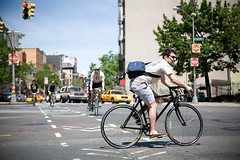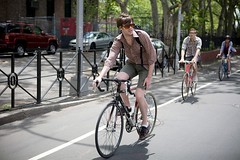 Emily Anne Epstein By one analysis, the redesigned bike lanes across the city have resulted in safer conditions for cyclists, motorists and pedestrians.
Emily Anne Epstein By one analysis, the redesigned bike lanes across the city have resulted in safer conditions for cyclists, motorists and pedestrians.Amid all the opinions raised for and against the city’s new street designs, Gaetano Puglio, manager of the Bean Café, minces no words: he doesn’t like them. Especially not the one in front of the café on First Avenue at East Third Street, the site of a collision on Labor Day.
Around 1:30 a.m. on Sept. 5, a Jeep Cherokee SUV heading west on Third Street tried to turn onto First and collided with a northbound taxi. The cab veered across the First Avenue bike lane and leapt the sidewalk, injuring five people, crushing a bicycle, and taking out the Bean’s front window. One bystander was injured critically and needed surgery at Bellevue. The collision remains under investigation and neither driver has been charged.
Like many observers, Mr. Puglio wondered if last summer’s redesign of the traffic lanes on First Avenue was a contributing factor. The redesign shifted the western parking lane inward to create a protected (“Copenhagenized”) bike lane and reserved the easternmost lane for buses. Mr. Puglio said that he always viewed the previous design – with a row of parked cars abutting the curb – as “a barrier to any kind of accident.”
But an independent analysis by the city’s former traffic commissioner shows that when lanes were redesigned in other parts of the city, the result was safer conditions for drivers, cyclists and pedestrians.
“Far fewer people have been injured; far fewer people have been hit by cars; far fewer cars have been involved in fatal accidents,” said Sam Schwartz, who in addition to serving as traffic commissioner has also worked as a transportation engineer and a cab driver. “Clearing the lanes and improving the visibility saves people. But no one could ever report on the accident that didn’t happen.”
Before studying the data, Mr. Schwartz expected the redesign plan to yield “minor benefits” on collision rates at best. Now, he finds the improvement “remarkable.”
While it is still too early to gauge the effects of lanes that were redesigned during the summer in the East Village, protected lanes citywide have the best record on Ninth Avenue, where injuries dropped 56 percent for all users, not just cyclists.
The benefits, Mr. Schwartz said, stem in large part from leaner traffic lanes. “The roads themselves have been put on diets,” Mr. Schwartz said. “And the diet increases the density of traffic, and that slows traffic down.”
With volume squeezed into fewer auto lanes, Mr. Schwartz said, the East Village is no longer a place where, when driving uptown, “you passed Houston Street on First Avenue and you floored your car.”
“Over long periods of time,” Mr. Schwartz said, “all of the components collectively have resulted in half the fatals that we had 20 years ago, so something is going right. Can we get even further? I believe we can; we can probably cut it in half again. I don’t know if we can get much further than that.”
Accident rates, he finds, respond to the interplay of five components: enforcement, engineering, education, legislation, and vehicles themselves. Adding seat belts and airbags to cars saved lives; the fad for tall, bulky SUVs had the opposite effect (Mr. Schwartz recalled a call from the head of a local emergency department about 10 years ago, reporting a trend toward chest and head injuries instead of broken legs).
Mr. Schwartz noted that so-called “Cash for Clunkers” programs have taken many older vehicles without airbags off the road. And the proliferation of GPS systems has reduced the overall vehicle miles traveled (and thus lowered the occurrence of crashes) by keeping drivers from getting lost.
Nationally, the number of fatalities from traffic accidents has dropped below 40,000 annually, he said, from highs above 50,000 a few decades ago.
City Councilwoman Rosie Mendez, whose district includes the East Village, believes that pedestrians, cyclists, and drivers all need training about how to use the new lanes.
“I’ve been told by some of my friends who’ve been out in Copenhagen that people have been conditioned, and they know not to step off the sidewalk,” Councilwoman Mendez said. “In New York, everyone steps off the sidewalk.”
Traffic regulations in the Netherlands and other countries with “strict liability” or “vulnerable user” laws includes the rebuttable presumption that responsibility for any collision always rests with the larger vehicle’s operator (in a bike-pedestrian accident, the cyclist; in a car-bike or car-pedestrian accident, the motorist), unless a driver can present evidence that a pedestrian or cyclist is unambiguously at fault.
Users of Dutch streets, aware that the legal burden of caution is proportionate to the capacity for harm, drive or ride accordingly. Lower death rates indicate that these laws are effective; they are not without advocates on this side of the Atlantic. “I think it’s something we might want to consider in this city,” Councilwoman Mendez said.




